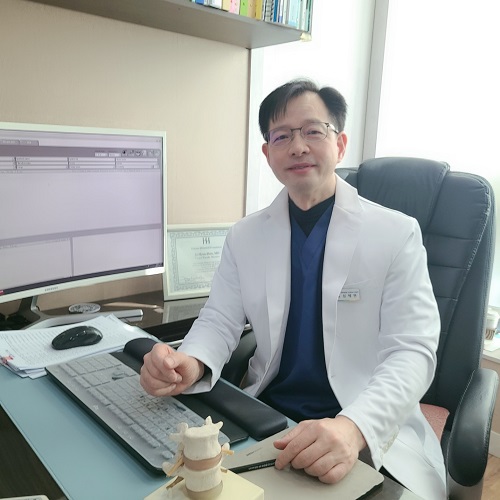Best Treatment Ligaments prolotherapy
Ligaments in the knee Ligaments vs Tendons
Ligaments Tendons Chronic pain

With the prolonged presence of COVID-19, an increasing number of people are suffering from chronic pain in Seoul due to factors such as remote work and restrictions on outdoor activities. ligaments tendons chronic pain refers to pain that persists for more than six months and, unlike acute pain, if left untreated, it can lead to various medical conditions. I learned more about the multiple causes of pain and recent prolotherapy treatments being carried out in many hospitals through an interview with Dr. Jae-Hyun Shim, President of the Korean Peripheral Nerve Society (a neurosurgeon and director of Cheongdam Spinal Nerve Surgery Center).
In recent times, the number of chronic ligaments pain patients has been increasing. Please explain the causes and treatment methods for various chronic pain conditions.
Generally, the causes of chronic pain can be broadly categorized into three main factors: musculoskeletal, neurological, and psychological. ligaments tendons chronic pain may sometimes result from the complex interplay of two or more elements.
When considering the physical causes, it is common for chronic pain to be attributed to issues with ligaments and tendons. In other words, chronic pain often occurs when ligaments and tendons become lax or damaged and do not fully recover, leading to a persistent state of joint instability, which can progress into chronic pain.
Additionally, neuropathic causes of ligaments tendons chronic pains are related to changes in nerve function or structure. You can think of nerves as conducting electrical signals, and just as problems with electrical wiring can lead to short circuits or poor conductivity, diseases affecting nerves can lead to pain. In such cases, even minor stimuli can be transmitted as pain, and mild pain can be perceived as severe. The peripheral nerves are surrounded by delicate nerves and blood vessels known as "nervi nervorum." When these structures are compressed or adhered to surrounding tissues, they can release inflammatory substances, leading to neuropathic pain.
Furthermore, chronic pain can also be caused by emotional disturbances or stress, with psychological factors playing a role. Psychological causes may encompass conditions such as anxiety, neurosis, hysteria, and depression, and they can manifest in long-standing chronic pain patients.
Prolotherapy" is a treatment method that is commonly used for chronic pain, but it may still be unfamiliar to the general public.
Prolotherapy" is also known as "Proliferation Therapy," which is a combination of the word "proliferation," meaning growth or increase, and "therapy." It is sometimes translated as "proliferation treatment" or "prolotherapy injection treatment." This treatment involves injecting a proliferative substance into damaged or weakened ligaments and tendons to stabilize the joints and spine, ultimately treating pain and promoting functional recovery. It can be considered a regenerative injection therapy.
What is the Hackett-Hemwall-Patterson Foundation" method in Prolotherapy?
Hackett is the one who developed Prolotherapy. It was perfected through extensive experience and research from the 1930s to the 1950s. Hemwall and Patterson are the individuals who inherited and advanced Hackett's methods. The international foundation known as the "Hackett-Hemwall-Patterson Foundation" educates physicians, conducts research and engages in medical activities in third-world countries using this treatment method. This foundation remains dedicated to the traditional practice of Prolotherapy.
How are diagnostic tests conducted for Prolotherapy in Korea?
The most important aspect of diagnosis is the patient's medical history. It involves assessing where the patient is experiencing discomfort, what exacerbates or alleviates the symptoms, whether there has been any trauma, and how long the symptoms have persisted. Next, a physical examination is conducted to evaluate the symptoms further, followed by X-ray imaging. In some cases, more advanced diagnostic tests such as MRI or CT scans may be necessary, and blood tests might also be conducted. In recent times, ultrasound testing has played a significant role in musculoskeletal diagnosis. Ultimately, a comprehensive diagnosis is reached by integrating the findings from these various tests.
Is Prolotherapy performed differently for different body parts?
The anatomical structures vary depending on the body part being treated, but the treatment principles are generally similar. When determining the treatment site, consideration is given to the load-bearing structures, referred to as "Biotensegrity.
For example, determining the stability of a joint relies not on the strongest ligament but on the weakest one, so accurately locating and injecting the most vulnerable ligament in that area can significantly impact the treatment outcome. Therefore, thorough examination and ample treatment experience are required. The typical treatment duration is usually around 3 to 4 weeks, with approximately 4 to 6 sessions. It is known that about 80% of patients experience improvement after this course of treatment.
What are the differences between steroid therapy and Prolotherapy when used for ligaments tendons chronic pain treatment?
Steroid injections and Prolotherapy are opposite approaches to treatment. Steroid injections aim to suppress inflammation to alleviate symptoms. Steroids are among the most potent anti-inflammatory drugs. They are used for systemic chronic inflammation conditions such as rheumatoid arthritis, refractory allergic diseases, and immunosuppression for organ transplant recipients. However, long-term use of steroids can lead to side effects such as diabetes due to increased blood sugar, avascular necrosis of the femoral head, immune suppression, hormonal changes, and more. Therefore, steroids should be used in appropriate amounts only when necessary.
When our body is injured, local inflammation occurs, and through the normal inflammatory response process, fibroblasts gather in the affected area to create new collagen fibers. This healing mechanism helps regenerate damaged ligaments and tendons, aiding the body's recovery. Prolotherapy is a highly effective regenerative treatment that induces this natural healing mechanism, effectively healing injuries. It is a fundamental treatment approach that addresses the root cause of the issue.
What is "Neuroprolotherapy" among Prolotherapy methods?
"Neuroprolotherapy" is a treatment method developed by Dr. John Lyftogt in New Zealand in 2009. This therapy involves injecting glucose around nerves to treat chronic pain. It is an effective treatment for neuropathic pain caused by peripheral nerve adhesions, compression, inflammation, or other factors. This approach involves identifying the underlying nerves responsible for neuropathic pain and administering glucose injections to alleviate nerve inflammation. Neuroprolotherapy has contributed to the development of hydro dissection, a procedure that uses ultrasound to identify problematic nerves and treat nerve inflammation with glucose or other injectables.
What are the side effects of Prolotherapy?
Using glucose as a proliferative agent in Prolotherapy itself has minimal side effects. However, complications can arise if nerves, blood vessels, or major organs are damaged during the process of using injection needles to stimulate and inject multiple areas. Therefore, a good understanding of anatomy is essential to safely and effectively perform Prolotherapy. In recent times, ultrasound has made it possible to achieve safer and more effective treatments.
What are the specific activities involved in actively practicing Prolotherapy?
Since 2010, he has been actively participating as an instructor in Prolotherapy conferences held by many domestic associations and the Prolotherapy Conference held at the University of Wisconsin School of Medicine and Public Health in the United States. He is also actively involved in Prolotherapy medical activities in Honduras and Mexico. This is pursuing prolotherapy education, researching to advance Prolotherapy, and sharing knowledge with challenging patients in third-world countries.
Are there any lifestyle guidelines or exercise methods for preventing ligaments tendons chronic pain?
Drinking enough water, consuming a balanced diet with essential nutrients, and supplementing necessary vitamins and minerals are important. Additionally, avoiding harmful foods is critical. Regularly engaging in moderate aerobic exercise, stretching, and strength training, getting sufficient sleep, and maintaining a consistent daily routine are also crucial for preventing ligaments chronic pain.
What I would like to emphasize to ligaments tendons chronic pain patients is
When ligaments tendons chronic pain persists for a long time, it can prevent you from enjoying activities you used to love. It may lead to symptoms like chronic fatigue, sleep disturbances, depression, and anxiety. Furthermore, it can weaken family bonds, reduce social activities, and even result in occupational losses. Therefore, I strongly encourage you not to let it go untreated for an extended period but rather seek proactive treatment and management from the early stages.


